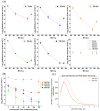Persistence of Phi6, a SARS-CoV-2 surrogate, in simulated indoor environments: Effects of humidity and material properties
- PMID: 39761208
- PMCID: PMC11703003
- DOI: 10.1371/journal.pone.0313604
Persistence of Phi6, a SARS-CoV-2 surrogate, in simulated indoor environments: Effects of humidity and material properties
Abstract
The SARS-CoV-2 virus caused the COVID-19 pandemic and brought major challenges to public health. It is transmitted via aerosols, droplets, and fomites. Among these, viral transmission through fomites is not well understood although it remains a very important transmission route. This motivated us to study how fomites play a role in viral transmission within controlled indoor environments. To achieve this, we investigated viral aerosol persistence on fomites under different humidity levels to mimic the built environment. We developed a protocol to study the effect of humidity on viral infectivity using a full-scale environmental chamber. The results show that the infectivity of aerosolized Phi6 in air decreased by ≥ 1 log10 as the relative humidity (RH) increased from 25% to 75% but then increased by ≥ 1 log10 as the RH further increased to 85%, resulting in a characteristic V-shape curve which varied with exposure time. Consistently, we show that although material properties may impact viral persistence, changes in the local humidity more significantly influence viral persistence on fomites. These results provide new insights into indoor fomite-mediated viral transmission under different environmental conditions. These findings will help guide the design of more effective strategies for viral control in indoor environments.
Copyright: © 2025 Parry-Nweye et al. This is an open access article distributed under the terms of the Creative Commons Attribution License, which permits unrestricted use, distribution, and reproduction in any medium, provided the original author and source are credited.
Conflict of interest statement
The authors have declared that no competing interests exist.
Figures




Similar articles
-
Increasing Temperature and Relative Humidity Accelerates Inactivation of SARS-CoV-2 on Surfaces.mSphere. 2020 Jul 1;5(4):e00441-20. doi: 10.1128/mSphere.00441-20. mSphere. 2020. PMID: 32611701 Free PMC article.
-
Monitoring COVID-19 Transmission Risks by Quantitative Real-Time PCR Tracing of Droplets in Hospital and Living Environments.mSphere. 2021 Jan 6;6(1):e01070-20. doi: 10.1128/mSphere.01070-20. mSphere. 2021. PMID: 33408231 Free PMC article.
-
Persistence of Bacteriophage Phi 6 on Porous and Nonporous Surfaces and the Potential for Its Use as an Ebola Virus or Coronavirus Surrogate.Appl Environ Microbiol. 2020 Aug 18;86(17):e01482-20. doi: 10.1128/AEM.01482-20. Print 2020 Aug 18. Appl Environ Microbiol. 2020. PMID: 32591388 Free PMC article.
-
Environmental dissemination of respiratory viruses: dynamic interdependencies of respiratory droplets, aerosols, aerial particulates, environmental surfaces, and contribution of viral re-aerosolization.PeerJ. 2023 Nov 24;11:e16420. doi: 10.7717/peerj.16420. eCollection 2023. PeerJ. 2023. PMID: 38025703 Free PMC article. Review.
-
Stability and transmissibility of SARS-CoV-2 in the environment.J Med Virol. 2023 Jan;95(1):e28103. doi: 10.1002/jmv.28103. Epub 2022 Sep 7. J Med Virol. 2023. PMID: 36039831 Free PMC article. Review.
References
-
- WHO Coronavirus (COVID-19) Dashboard 2020 [https://covid19.who.int/].
-
- COVID-19 has caused 6.9 million deaths globally, more than double what official reports show 2021 [https://www.healthdata.org/news-release/covid-19-has-caused-69-million-d...].
-
- Pettersson H, Manley B, Hernandez S. Tracking COVID-19’s global spread 2020 [https://www.cnn.com/interactive/2020/health/coronavirus-maps-and-cases/#!]
-
- Vasickova P, Pavlik I, Verani M, Carducci A. Issues concerning survival of viruses on surfaces. Food and Environmental Virology. 2010;2(1):24–34.
MeSH terms
Substances
LinkOut - more resources
Full Text Sources
Medical
Miscellaneous

